Ginger Garlic Paste Recipe
Updated: August 27, 2022, By Swasthi
Ginger garlic paste is one of the most basic essentials of Indian cooking. Apart from imparting a unique aroma to the foods it also aids in digestion and helps tenderize meats. While reaching out for a jar of ginger garlic paste from an Indian store may be an easier option, but you won’t get the same unique and refreshing flavors like the homemade paste. Your homemade ginger garlic paste is clean, pure and is free from preservatives. In this post I share the easiest way to make ginger garlic paste that you can store for several months.
About Ginger Garlic Paste
Ginger garlic paste is nothing but a spice blend made with fresh ginger root and garlic cloves. Sometimes various ingredients like oil, salt, vinegar and even turmeric are added to it as a preservative.
If you cook Indian food often, having a jar of ginger garlic paste in your refrigerator, is a great convenience. You don’t need to rinse, peel, chop and crush small quantities of ginger and garlic every time you cook.
In India, most traditional households crush ginger & garlic fresh in a mortar & pestle whenever required. I agree that nothing beats the flavor of the fresh paste & it really makes a difference to your final dish.
For many years, I have made ginger garlic paste fresh for every dish I cooked. Most recipes call for sautéing the onions, during which I would peel, grate and crush the ginger garlic right on the chopping board. This is one easier way but you still have to spend some time doing all of that.
About this Recipe
This 15 mins recipe will help you make ginger garlic paste enough for 4 to 6 weeks of cooking. I prefer to make smaller batches but you can double or triple the recipe if you prefer.
This recipe is simple and just needs 3 ingredients. Fresh ginger, garlic and a splash of oil. A lot of people also add turmeric or salt as a preservative but I don’t because this is how my mom always made & it keeps good for several months.
I use equal parts of ginger and garlic. But this varies from every family and some people also use 1 part ginger and 2 parts garlic. This depends on the kind of ginger and garlic you use. Read my pro tips for more info.
For more similar recipes you can check
Sambar powder
Rasam powder
Biryani masala powder
Idli podi
Garam masala
Photo Guide
How to Make Ginger Garlic Paste (Stepwise Photos)
1. Wash ginger under running. If required use a brush to get rid of mud deposits, if any. Pat dry completely. We use equal amounts of garlic and ginger. Here I use 125 grams each.
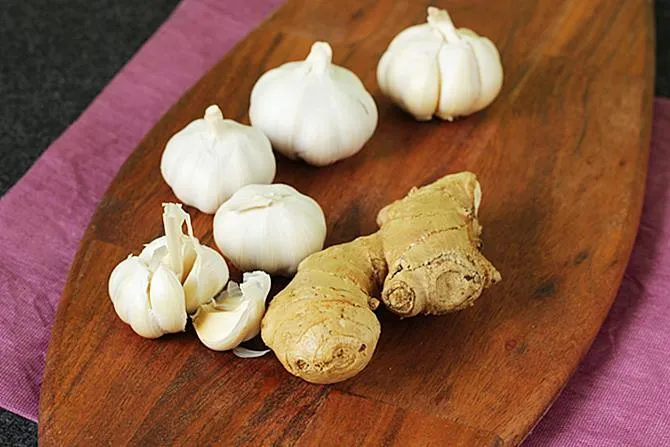
2. Peel the garlic cloves. Chop the ginger to small pieces.
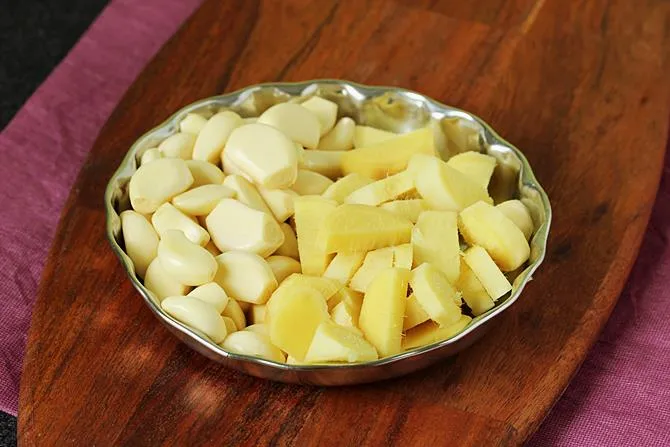
3. Add all the ingredients to a blender jar.
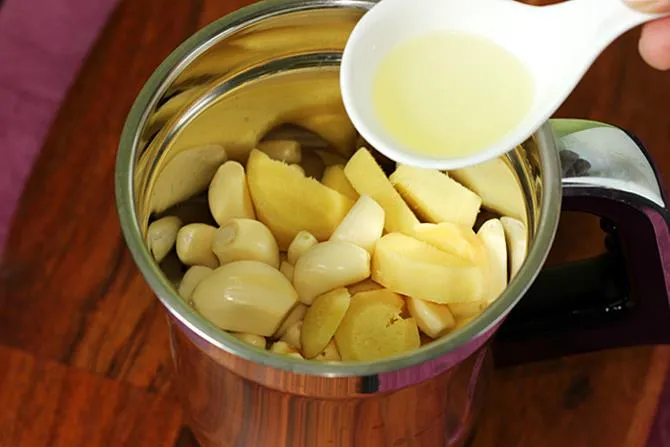
4. Turmeric, salt and oil are natural preservatives. Using any one of these is good enough to keep the ginger garlic paste good.
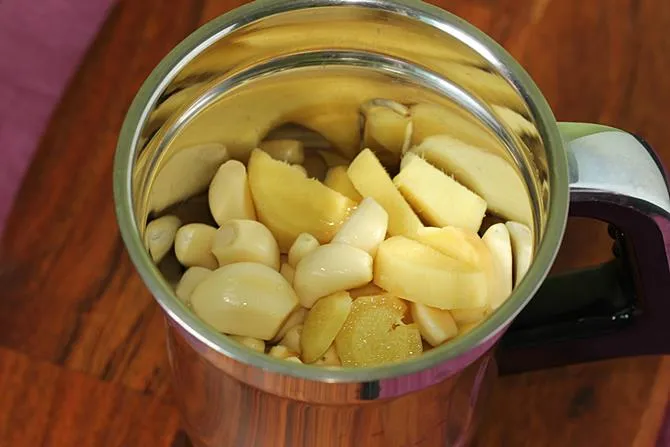
5. Make a fine paste until it turns pale and smooth.
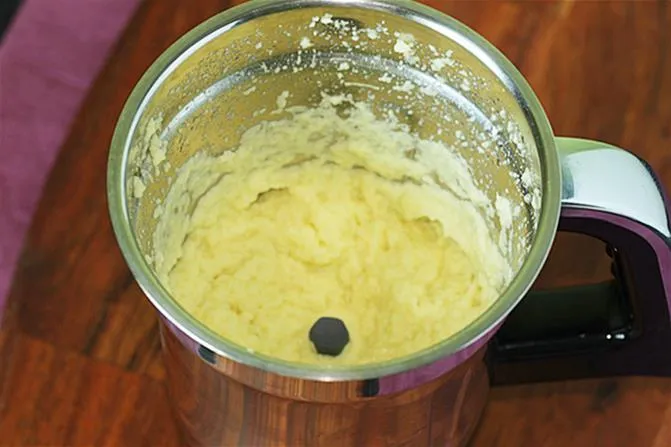
Storage
Store ginger garlic paste in a bottle and always use dry spoons to scoop out a little when needed. For more details on storage in fridge or freezer check the recipe card below.
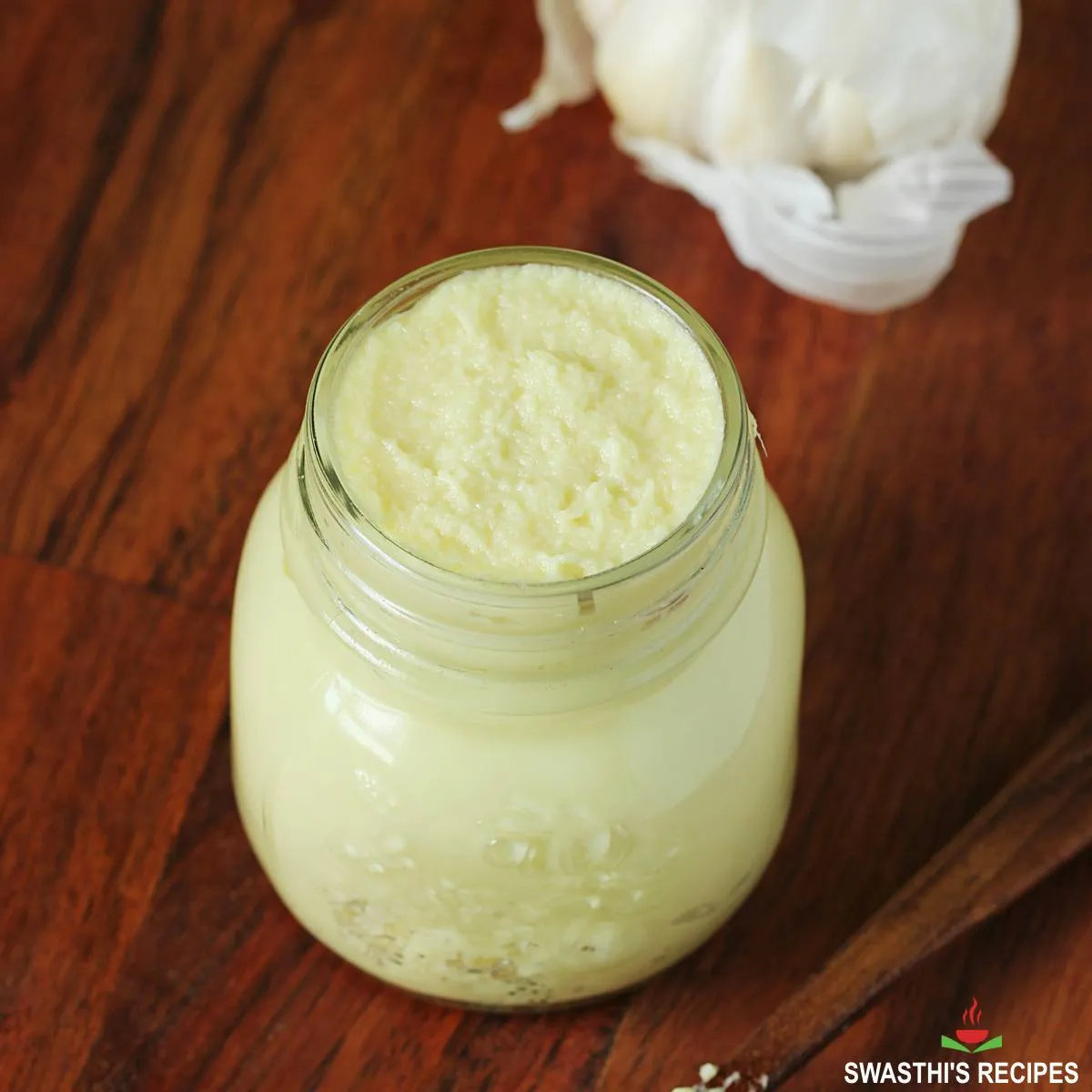
Pro Tips
Preservative used: Oil, turmeric and salt are the 3 ingredients which act as natural preservatives. But I feel oil is good enough which also enhances the aroma of the ground paste.
Ratio of ginger & garlic: There are different kinds of ginger root available in the market. The hybrid ginger and the non-hybrid kind. The non-hybrid kind has a very stronger aroma and taste. When used in equal quantities, the paste may lend a bitter taste. So I use 2 portions of garlic for 1 portion of ginger. If using hybrid ginger, 1:1 proportions work well.
Test Batch: If you are a newbie, run a small test batch to see how it works for you. After making your test batch cook something Indian and checkout the flavors.
If the ginger garlic paste is too gingery, blend the test batch with more garlic. Make a note of each addition so you arrive at a right proportion that suits you. If it is too garlicky, blend with more ginger
Why does ginger garlic paste turn green?
Garlic when crushed or chopped is prone to react with the minerals in the air or with the metals that it comes in contact with. Crushed garlic reacts with acidic ingredients. Sometimes pink salt, vinegar, lemon etc can also cause the discoloration in ground garlic.
So it is absolutely normal for the ground garlic to turn green or bluish green and is still safe to consume. For more details please use google search.
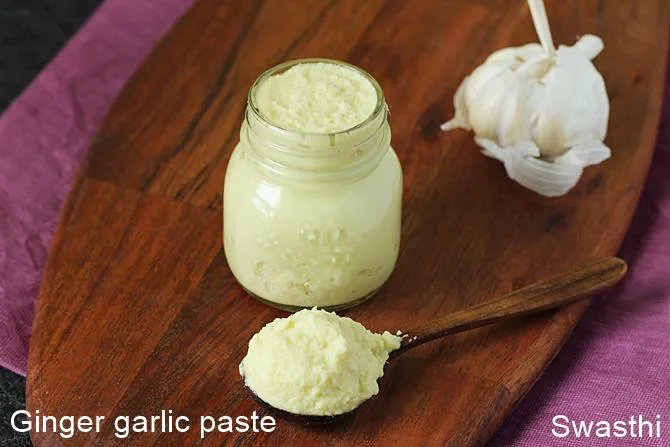
Related Recipes
Recipe Card
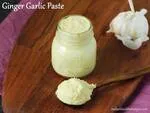
Ginger Garlic Paste
For best results follow the step-by-step photos above the recipe card
Ingredients (US cup = 240ml )
- 125 grams ginger (4.5 Ounce, refer notes)
- 125 grams garlic (4.5 Ounce, peeled)
- 1 tablespoon oil (I use organic refined coconut oil)
optional
- ½ teaspoon Turmeric (or haldi / optional)
Instructions
Preparation
- Rinse ginger under running water. Pat dry and peel it. Chop to half to 1 inch pieces.
- Cut off both the ends of garlic. Peel them.
- You can also add them to a box or tight lid container. Cover the jar and shake it vigorously for a minute. You will see the skin of the garlic loosens or comes off. This tip works only with certain kinds of garlic.
- You can also pour some oil over the garlic and rub off to loosen the skin. (This is how we peel garlic when we make pickles.)
How to Make Ginger Garlic Paste
- Add ginger, garlic and oil to a grinder/ blender jar. Blend well until smooth and light in color. Scrape off the sides and repeat blending until you see a smooth mixture.
- Transfer the ginger garlic paste to a clean dry glass jar. Refrigerate ginger garlic paste up to a month or 6 months in a freezer.
- To Freeze, transfer to ice tray and knock the tray to the counter a few times. Cover with a cling wrap. Once set transfer them to a ziplock bag. Use as desired whenever needed by defrosting one cube each time.
Notes
- You may start with lesser amounts of ginger and add as required to suit your taste.
- There are many kinds of ginger and they differ in flavor and strength. Run a small test batch to make ginger garlic paste. Cook with it first. If it is too gingery, add more garlic and blend. If it is too garlicy, add more ginger and blend. Note down the additions so you know the exact amounts that work well for you.
- I always peel the ginger. Sometimes it imparts bitter tones to the ginger garlic paste.
- Make sure you don’t use garlic with shoots. They will discolor your ginger garlic paste to green or blue overtime.
- Avoid using water to make ginger garlic paste, as the moisture splatters when you add it to the pan while cooking. You also want to fry the ginger garlic in oil to bring out the aroma and this is best achieved when you make the paste without water.
NUTRITION INFO (estimation only)
© Swasthi’s Recipes
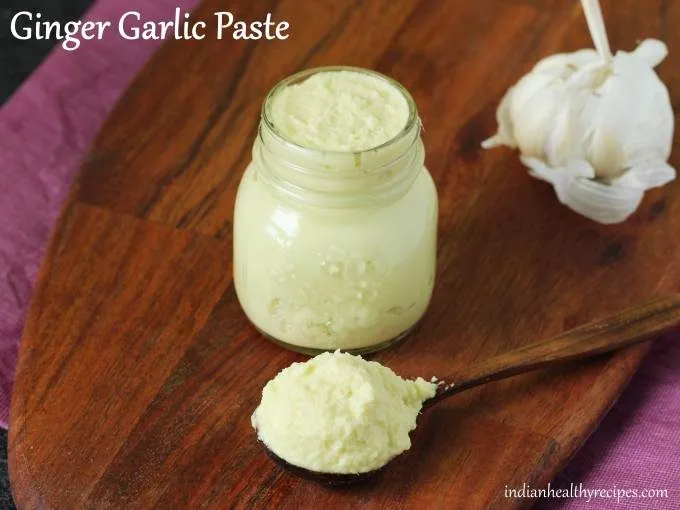
About Swasthi
I’m Swasthi Shreekanth, the recipe developer, food photographer & food writer behind Swasthi’s Recipes. My aim is to help you cook great Indian food with my time-tested recipes. After 2 decades of experience in practical Indian cooking I started this blog to help people cook better & more often at home. Whether you are a novice or an experienced cook I am sure Swasthi’s Recipes will assist you to enhance your cooking skills. More about me
Follow Swasthi’s Recipes
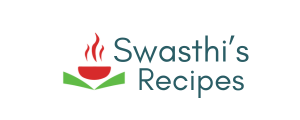
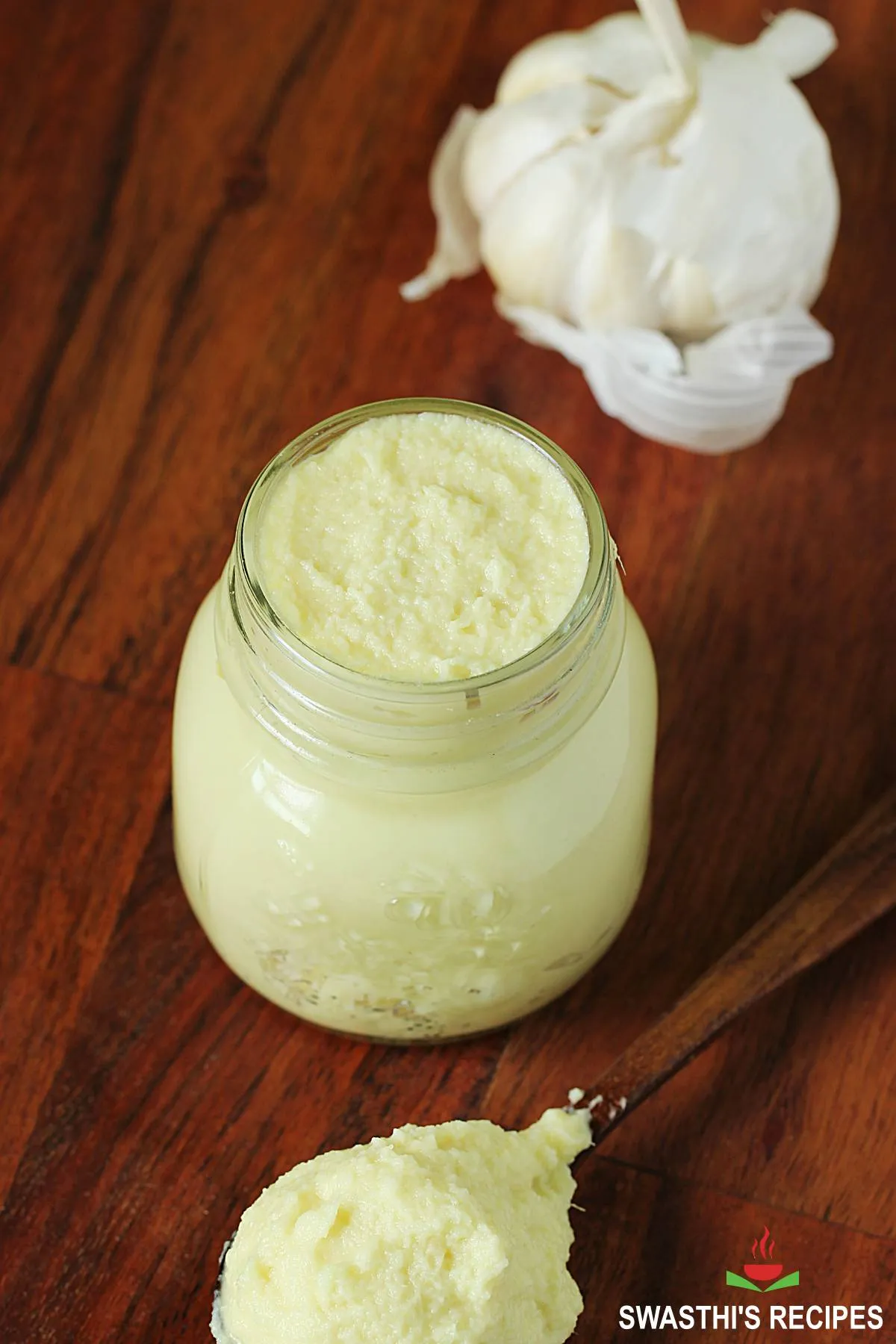
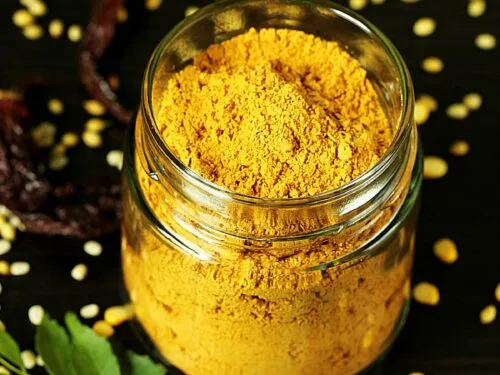
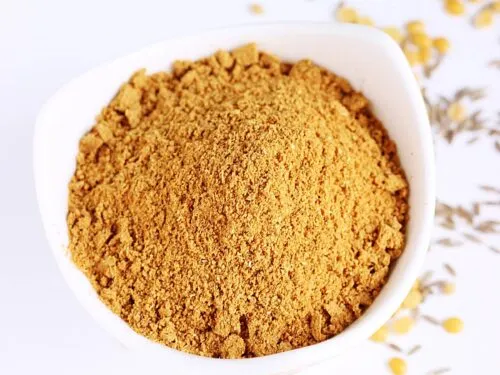
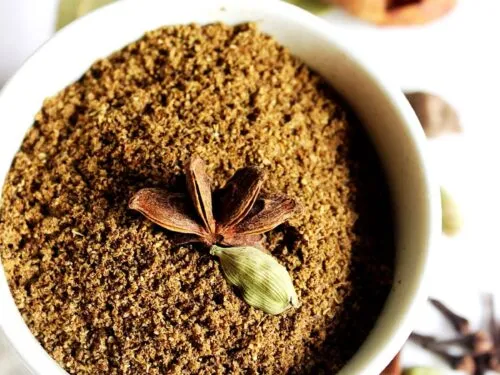
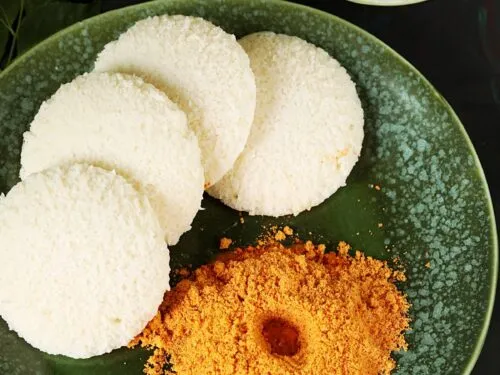
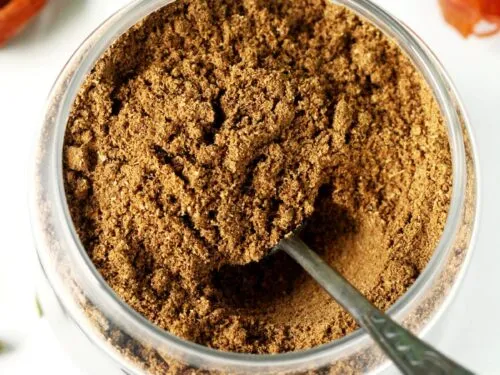
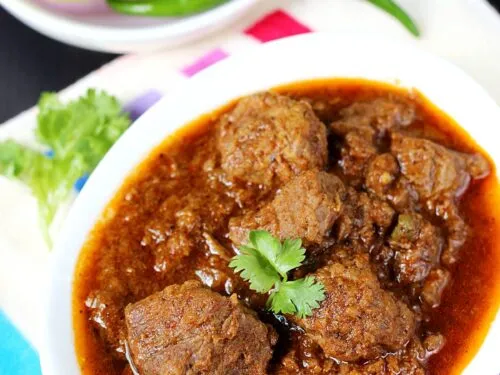
Comments
Hi! How do you know what kind of ginger you’re buying? Does the hybrid look different? TY!
Hi Kat,
Yes the hybrid ginger looks beautiful with very smooth skin, lesser dents, more juicy and the roots are larger compared to the other
Hi Swasthi,
I made this today, the new adapter for my grinder arrived this morning. It really does work a treat!
After our earlier discussion I decided to add a small, peeled fresh Turmeric root. I doubt it will be about long enough to tell if the fresh Turmeric works as a preservative. Very much looking forward to it saving me time.
Thanks,
Paul:-)
Hi Paul,
Yes you are right! Thanks for sharing back! Really appreciate!
Hello,
What difference it makes in using coconut oil particularly or any other oil if we use for the paste ? Kindly suggest speciality of coconut oil in ginger garlic paste!!
Hi Rahul,
We rarely use seed oils at home. So coconut oil or avocado oil is what I use most of the times for all our cooking. Coconut oil freezes well and oils like canola, safflower or sunflower don’t freeze well. So using coconut oil may increase the shelf life of ginger garlic paste. This could just be my thought and I found the paste stays good in the refrigerator for 2 months even without freezing. Hope this helps
Ok thanks…!!
hello,
if we add up turmeric which is optional what aroma is going to add up in a paste and if we replace ginger with a thai ginger (gagangal) will it be completely different paste .. or kindly suggest please,,!!!
Hello,
I personally don’t like the flavor of turmeric in ginger garlic paste. I felt the smell alters after a few days of refrigeration and the smell it produces while cooking is not the same as plain ginger garlic. You can’t replace ginger with galangal if you are making authentic Indian dishes. The flavor is different. But if you are making fusion dishes like thai tandoori chicken, you can use galangal. You can instead make a paste of galangal separately and add it when required either in Thai, Indian and fusion dishes
ok!! got it ….
Hi Swasthi,
As you probably realise, I am cooking Indian food almost daily at the moment, thanks to you. It is a joy!
However I am beginning to look for shortcuts such as this. I will definitely make a batch of it very soon. Before I do could I please ask if it would be OK to use a little fresh Haldi root when blending? If so what amount would you suggest?
Thankyou,
Paul:-)
Hi Paul,
I don’t have a tried and tested amount of turmeric root for this recipe. I have too many questions in my mind –
will it act as a preservative or spoil the paste because turmeric roots are boiled, dried and ground so powder is a preservative. But fresh root may work differently.
Will it turn out bitter and over powering
Fresh root stains the blender way more than powder.
But you can grind the turmeric separately. Refrigerate and freeze for further use.
Hope this helps you to decide
Thanks Swasthi, I will use powder if that’s the tried and tested way. I’m using Monkfish which is not the cheapest of fish so I don’t want to risk ruining it.
Thanks!
Hi Swasthi,
I would like to double this recipe. Do I just double the spice measurements?
Thank you.
Hi Debbie,
Yes double it.
Hi Swasthi
Thank you for another great recipe.
What a great idea! Considering how many times I’ve grated ginger and minced garlic in the past couple of weeks, this is going to be such a time saver.
Had to grate the ginger by hand and put the garlic through a press which was rather tedious. I must get a grinder like you have, that can handle wet and sticky, would you please tell us which one you have?
Thanks!
Hi Renee,
Yes this is certainly a time saver. I use a Indian model grinder but any regular but powerful blender like NutriBullet or a small food processor should work well. If you want the Indian model, look on amazon for a Indian mixer grinder. This kind lets you grind spices, lentils and many wet and dry foods. Over the years I have been using from brands like preeti, ultra and panasonic. Hope this helps
It does indeed, thank-you.
I looked on the Preeti website today, the selection is rather overwhelming and left me without a clue as to what I need.
I’ll have a look at the other ones you suggested. Thanks again for your help and fabulous recipes.
Thank you for sharing your recipes🙏🏽
Solved my problem and worked perfectly. Thank you
These are the best recipes ?
How much salt I should add in 1kg ginger garlic paste ?
Hi… Thanks for your site, I love it. I’ve made this garlic and ginger paste today but used extra virgin olive oil (I own an olive finca and have an abundance of it). Will this work?
Hi Gail,
You are welcome! Yes you can use it
How much oil do I need to use ?
Please check the recipe card. It is 125 grams ginger, 125 grams garlic and 1 tablespoon oil
Which is the best grinder for making ginger garlic paste and other curry pastes? Somehow the usual chutney jar in the mixer grinder requires a large quantity of oil to blend properly.
The grinder used in this post is from Preeti. I also use ultra mixer grinder, National Panasonic and Philips blender with a small glass jar. Look for something that has a small jar, that won’t require a lot of ingredients and oil/liquid.
I always have a large jar of this in my fridge. I use it for pretty much any recipe that calls for crushed garlic and/or grated ginger. In my rural community coconut oil is not an option, so I use peanut oil. I add both salt and turmeric.
Great recipes !!!! Delicious and informative
I made this and wrote a nice review but the pop-ups made me lose it.
Briefly thank you for convincing me to make my own garam marsala. I used a lot more than you call for but I also used more ginger and garlic.
Thank you for getting me over that hump! This was my first Indian dish ldue to fear of garam marsala.
Thank you Thom!
Actually we don’t have any pop-ups on the blog. Do you mean an ad?
The jarred stuff I bought from the store was foul and stinky, and could be considered a chemical weapon. This recipe is SO much better, better flavor and it smells fresh and delicious. Easy to make in a food processor, too.
Thank you Christopher.
Yes the store bought paste can’t be compared with the homemade.
Thank you
looks interesting, but be aware that garlic + oil stored at room temperature is a botulism risk. Botulism bacteria lives in garlic and grows very well in environments with low oxygen and water (such as in oil).
Hi Esther,
Thank you! I have edited the post to remove the method of storing it at room temperature.
Hi swasthi,
Can I just make a big batch and then freeze paste directly in 8 Oz Mason jars in freezer Instead ice cube trays ? I can then take out one jar as and when required and use it in a week or two by refrigerating the one in use.
Thanks,
Nilofar
Hi Nilofar,
Yes you can freeze it. I do it the same way but in smaller jars.